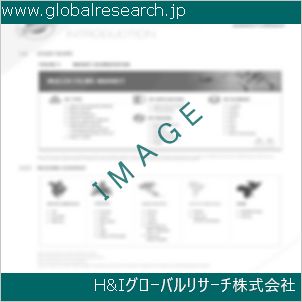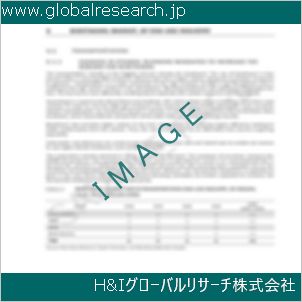Table of Contents
1 Industry Overview of Antimonytriiodide
1.1 Definition and Specifications of Antimonytriiodide
1.1.1 Definition of Antimonytriiodide
1.1.2 Specifications of Antimonytriiodide
1.2 Classification of Antimonytriiodide
1.3 Applications of Antimonytriiodide
1.3.1 Nuclear Application
1.3.2 Non-Nuclear Application
1.4 Industry Chain Structure of Antimonytriiodide
1.5 Industry Overview and Major Regions Status of Antimonytriiodide
1.5.1 Industry Overview of Antimonytriiodide
1.5.2 Global Major Regions Status of Antimonytriiodide
1.6 Industry Policy Analysis of Antimonytriiodide
1.7 Industry News Analysis of Antimonytriiodide
2 Manufacturing Cost Structure Analysis of Antimonytriiodide
2.1 Raw Material Suppliers and Price Analysis of Antimonytriiodide
2.2 Equipment Suppliers and Price Analysis of Antimonytriiodide
2.3 Labor Cost Analysis of Antimonytriiodide
2.4 Other Costs Analysis of Antimonytriiodide
2.5 Manufacturing Cost Structure Analysis of Antimonytriiodide
2.6 Manufacturing Process Analysis of Antimonytriiodide
3 Technical Data and Manufacturing Plants Analysis of Antimonytriiodide
3.1 Capacity and Commercial Production Date of Global Antimonytriiodide Major Manufacturers in 2023
3.2 Manufacturing Plants Distribution of Global Antimonytriiodide Major Manufacturers in 2023
3.3 R&D Status and Technology Source of Global Antimonytriiodide Major Manufacturers in 2023
3.4 Raw Materials Sources Analysis of Global Antimonytriiodide Major Manufacturers in 2023
4 Capacity, Production and Revenue Analysis of Antimonytriiodide by Regions, Types and Manufacturers
4.1 Global Capacity, Production and Revenue of Antimonytriiodide by Regions 2019-2024
4.2 Global and Major Regions Capacity, Production, Revenue and Growth Rate of Antimonytriiodide 2019-2024
4.3 Global Capacity, Production and Revenue of Antimonytriiodide by Types 2019-2024
4.4 Global Capacity, Production and Revenue of Antimonytriiodide by Manufacturers 2019-2024
5 Price, Cost, Gross and Gross Margin Analysis of Antimonytriiodide by Regions, Types and Manufacturers
5.1 Price, Cost, Gross and Gross Margin Analysis of Antimonytriiodide by Regions 2019-2024
5.2 Price, Cost, Gross and Gross Margin Analysis of Antimonytriiodide by Types 2019-2024
5.3 Price, Cost, Gross and Gross Margin Analysis of Antimonytriiodide by Manufacturers 2019-2024
6 Consumption Volume, Consumption Value and Sale Price Analysis of Antimonytriiodide by Regions, Types and Applications
6.1 Global Consumption Volume and Consumption Value of Antimonytriiodide by Regions 2019-2024
6.2 Global and Major Regions Consumption Volume, Consumption Value and Growth Rate of Antimonytriiodide 2019-2024
6.3 Global Consumption Volume and Consumption Value of Antimonytriiodide by Types 2019-2024
6.4 Global Consumption Volume and Consumption Value of Antimonytriiodide by Applications 2019-2024
6.5 Sale Price of Antimonytriiodide by Regions 2019-2024
6.6 Sale Price of Antimonytriiodide by Types 2019-2024
6.7 Sale Price of Antimonytriiodide by Applications 2019-2024
6.8 Market Share Analysis of Antimonytriiodide by Different Sale Price Levels
7 Supply, Import, Export and Consumption Analysis of Antimonytriiodide
7.1 Supply, Consumption and Gap of Antimonytriiodide 2019-2024
7.2 Global Capacity, Production, Price, Cost, Revenue, Supply, Import, Export and Consumption of Antimonytriiodide 2019-2024
7.3 USA Capacity, Production, Price, Cost, Revenue, Supply, Import, Export and Consumption of Antimonytriiodide 2019-2024
7.4 EU Capacity, Production, Price, Cost, Revenue, Supply, Import, Export and Consumption of Antimonytriiodide 2019-2024
7.5 China Capacity, Production, Price, Cost, Revenue, Supply, Import, Export and Consumption of Antimonytriiodide 2019-2024
7.6 Japan Capacity, Production, Price, Cost, Revenue, Supply, Import, Export and Consumption of Antimonytriiodide 2019-2024
8 Major Manufacturers Analysis of Antimonytriiodide
8.1 Manufacturer One
8.1.1 Company Profile
8.1.2 Product Picture and Specifications
8.1.2.1 Type I
8.1.2.2 Type II
8.1.2.3 Type III
8.1.3 Capacity, Production, Price, Cost, Gross and Revenue
8.1.4 Contact Information
8.2 Manufacturer Two
8.2.1 Company Profile
8.2.2 Product Picture and Specifications
8.2.2.1 Type I
8.2.2.2 Type II
8.2.2.3 Type III
8.2.3 Capacity, Production, Price, Cost, Gross and Revenue
8.2.4 Contact Information
8.3 Manufacturer Three
8.3.1 Company Profile
8.3.2 Product Picture and Specifications
8.3.2.1 Type I
8.3.2.2 Type II
8.3.2.3 Type III
8.3.3 Capacity, Production, Price, Cost, Gross and Revenue
8.3.4 Contact Information
8.4 Manufacturer Four
8.4.1 Company Profile
8.4.2 Product Picture and Specifications
8.4.2.1 Type I
8.4.2.2 Type II
8.4.2.3 Type III
8.4.3 Capacity, Production, Price, Cost, Gross and Revenue
8.4.4 Contact Information
8.5 Manufacturer Five
8.5.1 Company Profile
8.5.2 Product Picture and Specifications
8.5.2.1 Type I
8.5.2.2 Type II
8.5.2.3 Type III
8.5.3 Capacity, Production, Price, Cost, Gross and Revenue
8.5.4 Contact Information
…
9 Marketing Trader or Distributor Analysis of Antimonytriiodide
9.1 Marketing Channels Status of Antimonytriiodide
9.2 Traders or Distributors with Contact Information of Antimonytriiodide by Regions
9.3 Ex-work Price, Channel Price and End Buyer Price Analysis of Antimonytriiodide
9.4 Regional Import, Export and Trade Analysis of Antimonytriiodide
10 Industry Chain Analysis of Antimonytriiodide
10.1 Upstream Major Raw Materials Suppliers Analysis of Antimonytriiodide
10.1.1 Major Raw Materials Suppliers with Contact Information Analysis of Antimonytriiodide
10.1.2 Major Raw Materials Suppliers with Supply Volume Analysis of Antimonytriiodide by Regions
10.2 Upstream Major Equipment Suppliers Analysis of Antimonytriiodide
10.2.1 Major Equipment Suppliers with Contact Information Analysis of Antimonytriiodide
10.2.2 Major Equipment Suppliers with Product Pictures Analysis of Antimonytriiodide by Regions
10.3 Downstream Major Consumers Analysis of Antimonytriiodide
10.3.1 Major Consumers with Contact Information Analysis of Antimonytriiodide
10.3.2 Major Consumers with Consumption Volume Analysis of Antimonytriiodide by Regions
10.4 Supply Chain Relationship Analysis of Antimonytriiodide
11 Development Trend of Analysis of Antimonytriiodide
11.1 Capacity, Production and Revenue Forecast of Antimonytriiodide by Regions and Types
11.1.1 Global Capacity, Production and Revenue of Antimonytriiodide by Regions 2024-2029
11.1.2 Global and Major Regions Capacity, Production, Revenue and Growth Rate of Antimonytriiodide 2024-2029
11.1.3 Global Capacity, Production and Revenue of Antimonytriiodide by Types 2024-2029
11.2 Consumption Volume and Consumption Value Forecast of Antimonytriiodide by Regions, Types and Applications
11.2.1 Global Consumption Volume and Consumption Value of Antimonytriiodide by Regions 2024-2029
11.2.2 Global and Major Regions Consumption Volume, Consumption Value and Growth Rate of Antimonytriiodide 2024-2029
11.2.3 Global Consumption Volume and Consumption Value of Antimonytriiodide by Types 2024-2029
11.2.4 Global Consumption Volume and Consumption Value of Antimonytriiodide by Applications 2024-2029
11.3 Supply, Import, Export and Consumption Forecast of Antimonytriiodide
11.3.1 Supply, Consumption and Gap of Antimonytriiodide 2024-2029
11.3.2 Global Capacity, Production, Price, Cost, Revenue, Supply, Import, Export and Consumption of Antimonytriiodide 2024-2029
11.3.3 USA Capacity, Production, Price, Cost, Revenue, Supply, Import, Export and Consumption of Antimonytriiodide 2024-2029
11.3.4 EU Capacity, Production, Price, Cost, Revenue, Supply, Import, Export and Consumption of Antimonytriiodide 2024-2029
11.3.5 China Capacity, Production, Price, Cost, Revenue, Supply, Import, Export and Consumption of Antimonytriiodide 2024-2029
11.3.6 Japan Capacity, Production, Price, Cost, Revenue, Supply, Import, Export and Consumption of Antimonytriiodide 2024-2029
12 New Project Investment Feasibility Analysis of Antimonytriiodide
12.1 New Project SWOT Analysis of Antimonytriiodide
12.2 New Project Investment Feasibility Analysis of Antimonytriiodide
13 Conclusion of the Global Antimonytriiodide (CAS 7790-44-5) Industry 2024 Market Research Report
| ※参考情報 三ヨウ化アンチモン(Antimony triiodide)は、化学式SbI₃で表される化合物で、CAS番号は7790-44-5です。この化合物は、アンチモン(Sb)とヨウ素(I)の化合物であり、固体の状態で存在します。三ヨウ化アンチモンは、主に無機化合物として分類され、特に触媒や半導体材料、さらには医薬品や農薬の合成において重要な役割を果たしています。 三ヨウ化アンチモンはその特異な物理的特性から注目されています。室温では黒色の結晶性固体として存在し、光の遮蔽力が高いことから、光学的な特性を活かした応用がなされています。この化合物は水に溶けにくいものの、有機溶媒には溶解する傾向があります。さらに、加熱すると揮発性を示すため、特定の温度条件下では気体としても存在することができます。 特に、三ヨウ化アンチモンは半導体材料としての特性があり、電子デバイスにおいて用いられます。このため、半導体工業や太陽電池などの関連技術での応用が期待されています。さらに、光学機器においても利用されることがあり、高い屈折率と吸収特性を有しているため、特定の光学フィルターやレンズの材料としても使用されます。 三ヨウ化アンチモンの用途は多岐にわたります。まず第一に、触媒としての利用が挙げられます。特に化学反応を促進する役割を果たし、さまざまな化合物の合成において不可欠な試薬とされています。例えば、有機合成化学においては、三ヨウ化アンチモンを触媒とした反応が広く実施されています。 また、医薬品の合成においても、その重要性が増してきています。三ヨウ化アンチモンは、特定の医薬品の中間体として利用されることがあり、その効能や応用研究が活発に行われています。さらに、農薬の開発においても使用されることがあり、特定の農薬成分の合成において不可欠です。 関連技術としては、有機合成化学や触媒化学の分野での研究が進行中です。これにより、新しい反応経路や合成法が開発され、より効率的な生産が可能になることが期待されています。特に、環境への配慮から、より持続可能なプロセスの開発が求められる中で、三ヨウ化アンチモンの利用が注目されています。 さらに、三ヨウ化アンチモンはその特性から、環境科学の分野でも研究が進められています。特に、重金属汚染のモニタリングや除去技術においてその応用が期待されています。重金属を吸着する能力を持つことから、環境修復に資する素材としての可能性が考えられています。 一方で、三ヨウ化アンチモンの取り扱いに際しては注意が必要です。特に、ヨウ素を含む化合物のため、一定の毒性があり、適切な安全対策が求められます。作業時は保護具を着用し、換気を十分に行うことが重要です。また、廃棄物としての処理においても、その特性に応じた適切な方法が求められます。 最後に、今後の研究動向について触れておきます。学術界や産業界において、三ヨウ化アンチモンに関する新しい応用や合成法の開発が進められており、将来的には新たな技術革新が期待されます。特に、ナノテクノロジーや新材料合成における研究が進む中で、三ヨウ化アンチモンの有用性が再評価されることが予想されます。 以上のように、三ヨウ化アンチモンはその化学的特性に基づき、多様な分野での応用が期待される重要な化合物であることが理解できます。今後の研究が進むことで、さらに新たな可能性が拓かれることでしょう。 |
❖ 免責事項 ❖
http://www.globalresearch.jp/disclaimer












